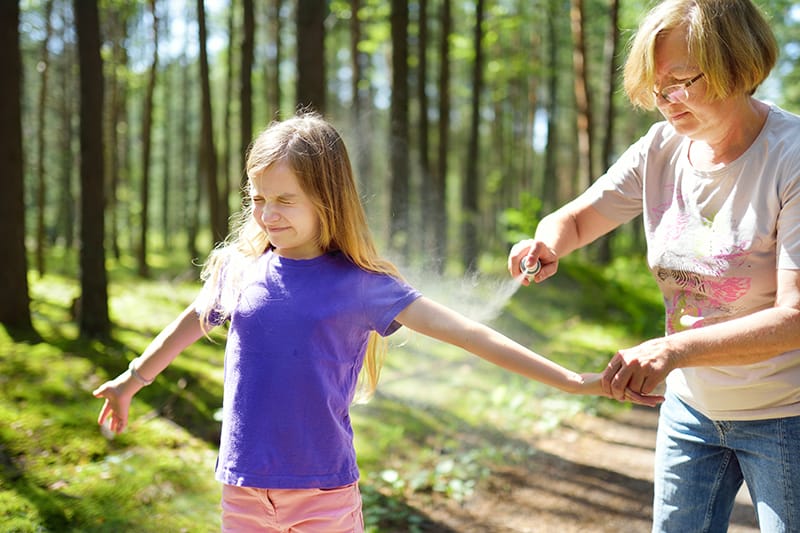"Parents often have questions about how to protect their children during the summer months,” says Dan Pelzer, MD, a pediatrician with The Iowa Clinic. “It’s natural to see a long list of ingredients on a bottle of sunscreen or insect repellent and feel a little overwhelmed.”
So, what’s a parent to do?
Dr. Pelzer says, “Kids love to be outside. It’s great for their physical health and encourages imagination and screen-free play. The first — and best — line of defense is to prepare appropriately. Making a routine of applying sunscreen and bug spray every morning allows children to participate the activity and prevents the inevitable mad dash out the door later in the day.”
Sun protection
Whenever kids are outdoors during daylight, Dr. Pelzer says they should wear hats, sunglasses with UV protection, and loose-fitting, breathable clothing that covers arms and legs. Additionally:
- Children under 6 months should not be exposed to direct sunlight at all. Keep them in the shade and avoid relying on sunscreen for any type of sun protection.
- Children 6 months to 6 years should also avoid direct sunlight, especially from 10 a.m. to 2 p.m. Use sunscreen containing physical blockers, such as zinc or titanium, rather than chemical blockers that can be absorbed into the skin.
- Children 6 to 12 years should also avoid sun exposure during peak hours (10 a.m. to 2 p.m.) and reapply sunscreen every 90 minutes to 2 hours.
When choosing a sunscreen, Dr. Pelzer says, “Be wary of marketing messages such as ‘safe for babies’ or ‘safe for children.’ Instead, read product labels.” He recommends sunscreens that:
- have an SPF of 30 or higher;
- are “water resistant” (lasting 40 minutes in water) or “very water resistant” (80 minutes); and
- provide broad spectrum protection, which shields both UVA and UVB rays.
“Although popular, spray-on sunscreens are not recommended for children. Their effectiveness has not been proven, plus children can inhale the spray,” Dr. Pelzer warns.
Guarding against insect-borne disease
To reduce the risk of bites from ticks, mosquitoes and other insects, Dr. Pelzer advises parents to:
- use mosquito netting over infant carriers.
- clothe children in long pants and long sleeves.
- keep children indoors between dusk and dawn, when mosquitoes are most active.
- avoid areas where mosquitoes hang out (such as standing water; tall grasses, weeds and brush; uncovered foods; gardens).
- avoid wooded and grassy areas, where ticks are thickest.
- use insect repellent sparingly on children, following the guidelines below.
Do's and Don'ts of bug repellents
| DO | DON'T |
|---|---|
| Do read product labels. Follow all directions and precautions. | Don’t use DEET or picaridin-containing products on children younger than 2 months. |
| Do use repellants containing 5-10% picaridin or 10-30% DEET when child is 2 months and older. | Don’t use products containing lemon eucalyptus until child is at least 3 years of age. |
| Do spray the repellent onto your own hands and then apply to young children. Supervise older children when they apply repellent. | Don’t spray insect repellent directly onto the face. Instead, spray a little on your hands and carefully apply it on your child’s face; avoid eyes and mouth. |
| Do apply sparingly only to the outside of clothing and on exposed skin. (Products containing permethrin should not be applied to skin) | Don’t apply insect repellent to child’s hands, which often touch the eyes and mouth. |
| Do apply sunscreen before applying bug repellent. | Don’t use bug spray under clothing. |
| Do apply in open areas to avoid your child inhaling repellent. | Don’t use more than necessary – it won’t increase effectiveness. Use sparingly on ears. |
| Do apply right before going outdoors; wash off with soap and water immediately after coming indoors. Wash clothing before it’s worn again. | Don’t use combination products that contain both sunscreen and bug repellent. This is because sunscreen should be reapplied every few hours, but your child shouldn’t be exposed to that much bug repellent. |
| Do keep repellents out of reach of children. | Don’t spray on cuts, wounds, rashes or irritated skin. |
Sources:
https://well.blogs.nytimes.com/2016/07/01/sunscreen-and-bug-spray-childrens-summer-skin-care/
https://www.healthychildren.org/English/safety-prevention/at-play/Pages/Insect-Repellents.aspx
https://idph.iowa.gov/Portals/1/userfiles/79/West%20Nile/Use%20of%20Mosquito%20Repellant%20on%20Children%20Factsheet.pdf
https://www.webmd.com/children/sunburn-prevention-in-young-children
https://www.aap.org/en-us/about-the-aap/aap-press-room/news-features-and-safety-tips/pages/summer-safety-tips.aspx
